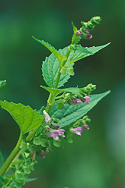
Photo © Steven Foster
Introduction
Skullcap is a perennial in the mint family that grows to 3 feet and is native to the eastern United States.1 It can be found throughout North America and its blue flowers appear from July through September.1,2 The aboveground parts of the plant are used.1 History and Cultural Significance
Traditionally, the leaves of this herb were steeped to produce a tea or tonic.1 Utilized by the Cherokee and other tribes of North America to promote menstruation, skullcap was employed in the ceremonial transition of young girls to womanhood.1,2 Native Americans also used skullcap for treating diarrhea and breast pains, and to keep the throat clean.3 Skullcap became a popular treatment in the 1700s for hydrophobia or rabies, resulting in one of its common names, mad-dog weed.1,2,4 In folk medicine, skullcap was used as a sedative. Skullcap tea was also used for a variety of other conditions including anxiety.5 Modern Research
Recent research has demonstrated that skullcap may be effective at reducing anxiety in a study population of healthy volunteers.6 There are currently no clinical studies on the external use of skullcap. Recent animal studies indicate that skullcap may have anti-inflammatory properties, but human clinical studies would be needed to confirm this.1 Future Outlook
Skullcap grows naturally in the wild and mass, systematic cultivation efforts have not been fully developed.2 Other than reports of the susceptibility of skullcap to two virus pathogens, tomato spotted wilt virus and another necrotic spot virus, major problems with diseases or insects have not been reported.2 Ever-present threats to natural growth areas include growth and development. However, it is unclear what impact this population pressure may have on the production of skullcap. References
1 DerMarderosian A, Beutler JA, eds. The Review of Natural Products: The Most Complete Source of Natural Product Information. 3rd ed. St. Louis, MO: Facts and Comparisons; 2002. 2 Joshee N, Patrick TS, Mentreddy RS, and Yadav AK. Skullcap: Potential Medicinal Crop. Trends in New Crops and New Uses. Alexandria, VA: ASHS Press; 2002. 3 Moerman DE. Native American Ethnobotany. Portland, OR; Timber Press Inc.: 1998. 4 Foster S, Tyler VE. Tyler’s Honest Herbal. 4th ed. Binghamton, NY: Haworth Herbal Press; 1999. 5 Foster S, Duke JA. A Field Guide to Medicinal Plants: Eastern and Central North America. Boston; Houghton Mifflin Co: 1990. 6 Wolfson P, Hoffman DL. An investigation into the efficacy of Scutellaria lateriflora in healthy volunteers. Alternative Therapies in Health and Medicine. 2003;2:74-78.
|